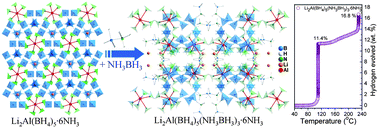A synergistic strategy established by the combination of two H-enriched B–N based hydrides towards superior dehydrogenation†
Abstract
A strategy for establishing Hδ+⋯−δH interactions by the combination of two kinds of H-enriched B–N based hydrides, ammine metal borohydrides (AMBs) and ammonia borane (AB), to achieve superior dehydrogenation properties is reported. Two novel combined complexes: Al(BH4)3·6NH3–4AB and Li2Al(BH4)5(NH3BH3)3·6NH3 were successfully synthesized. Structural analysis revealed that a partial NH3 unit transferred from Al(BH4)3·6NH3 to AB, resulting in the formation of two new phases of Al(BH4)3·5.4NH3 and NH3BH3·0.15NH3 in the Al(BH4)3·6NH3–4AB composite. In contrast, Li2Al(BH4)5(NH3BH3)3·6NH3 formed with a single-phase that was indexed to a cubic unit cell with a refined lattice parameter, a = 23.1220(3) Å. The structure of Li2Al(BH4)5(NH3BH3)3·6NH3 is composed of alternate Li+, [Al(NH3)6]3+ and AB layers stacked along the b-axis as a 3D framework. Compared to the unitary compound, the H-enriched complex system presented a mutual dehydrogenation improvement in terms of a considerable decrease in the dehydrogenation temperature and the preferable suppression of the simultaneous release of by-products; for example, over 11 wt% of hydrogen, with a purity of >98 mol%, can be released from both Al(BH4)3·6NH3–4AB and Li2Al(BH4)5(NH3BH3)3·6NH3 below 120 °C. The significantly improved dehydrogenation in the H-enriched complex system can be attributed to the initial interaction between the AB and an NH3 group (from the AMBs), which results in the balanced B–H and N–H units in the AMBs, thereby leading to a more activated and thorough Hδ+⋯−δH interaction in the composite. Moreover, an ammonia-liquification technique was employed to impregnate the complex system into a hypercrosslinked nano-porous polymer (PSDB) template, resulting in the average particle size of the Al(BH4)3·6NH3–4AB composite to be <5 nm, which enables it to release more than 10 wt% high-pure hydrogen (>99.8 mol%) below 110 °C. These advanced dehydrogenation properties affirm Al(BH4)3·6NH3–4AB and Li2Al(BH4)5(NH3BH3)3·6NH3 as strong candidates for potential hydrogen storage materials.


 Please wait while we load your content...
Please wait while we load your content...